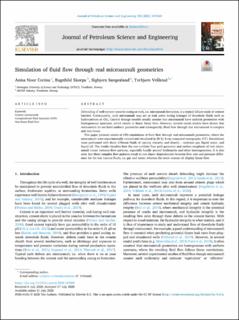Simulation of fluid flow through real microannuli geometries
Peer reviewed, Journal article
Published version
Permanent lenke
https://hdl.handle.net/11250/2685632Utgivelsesdato
2020Metadata
Vis full innførselSamlinger
- Publikasjoner fra CRIStin - SINTEF AS [5801]
- SINTEF Industri [1566]
Originalversjon
10.1016/j.petrol.2020.107669Sammendrag
Debonding of well cement towards casing or rock, i.e. microannuli formation, is a typical failure mode of cement barriers. Consequently, such microannuli may act as leak paths during leakages of downhole fluids such as hydrocarbons or CO2. Current leakage models usually assume that microannuli have uniform geometries with homogeneous apertures, which results in linear Darcy flow. However, several recent studies have shown that microannuli do not have uniform geometries and subsequently, fluid flow through real microannuli is complex and non-linear.
This paper presents results of CFD simulations of fluid flow through real microannuli geometries, where the microannuli were experimentally created and visualized in 3D by X-ray computed tomography (CT). Simulations were performed with three different fluids of varying viscosity and density – methane gas, liquid water, and liquid oil. The results visualize how the non-uniform flow path geometry and surface roughness of real microannuli create tortuous flow patterns, especially locally around bottlenecks and other heterogeneities. It is also seen that these complex flow patterns result in non-linear dependencies between flow rate and pressure difference for the less viscous fluids, i.e. gas and water, whereas the more viscous oil display linear flow.

